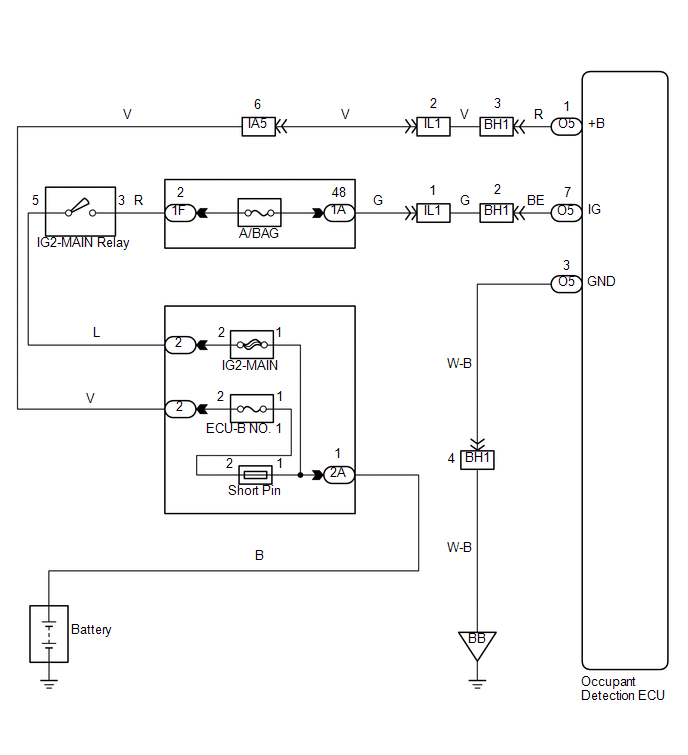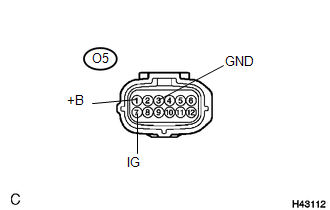Toyota Tacoma (2015-2018) Service Manual: Open in Occupant Classification ECU Battery Positive Line (B1794)
DESCRIPTION
DTC B1794 is set when a malfunction is detected in the occupant detection ECU.
|
DTC No. |
DTC Detections Conditions |
Trouble Areas |
|---|---|---|
|
B1794 |
|
|
HINT:
- When DTC B1650/32 is detected as a result of troubleshooting the supplemental restraint system, perform troubleshooting for DTC B1794 of the occupant classification system.
- Use the Techstream to check for DTCs of the occupant detection ECU, otherwise the DTCs cannot be read.
WIRING DIAGRAM

PROCEDURE
|
1. |
CHECK DTC |
(a) Turn the ignition switch to ON.
(b) Clear any DTCs stored in the memory (See page
.gif) ).
).
HINT:
- First clear DTCs stored in the occupant detection ECU and then in the airbag sensor assembly.
- Use the Techstream to clear the DTCs of the occupant detection ECU, otherwise the DTCs cannot be cleared.
(c) Turn the ignition switch off, and wait for at least 10 seconds.
(d) Turn the ignition switch to ON.
(e) Using the Techstream, check for DTCs of the occupant detection ECU (See page
.gif) ).
).
OK:
DTC B1794 is not output.
HINT:
DTCs other than B1794 may be output at this time, but they are not related to this check.
| OK | .gif) |
USE SIMULATION METHOD TO CHECK |
|
|
2. |
CHECK CONNECTION OF CONNECTORS |
(a) Turn the ignition switch off.
(b) Disconnect the negative (-) terminal cable from the battery, and wait for at least 90 seconds.
(c) Check that the connectors are properly connected to the airbag sensor assembly and the occupant detection ECU.
OK:
The connectors are properly connected.
| NG | .gif) |
CONNECT CONNECTORS |
|
|
3. |
CHECK CONNECTORS |
(a) Check that the connectors (on the occupant detection ECU side) are not damaged
(See page .gif) ).
).
OK:
The connectors are not deformed or damaged.
| NG | .gif) |
REPAIR OR REPLACE WIRE HARNESS |
|
|
4. |
CHECK WIRE HARNESS (SOURCE VOLTAGE) |
|
(a) Turn the ignition switch off. |
|
(b) Disconnect the negative (-) terminal cable from the battery, and wait for at least 90 seconds.
(c) Disconnect the O5 connector from the occupant detection ECU.
(d) Connect the negative (-) terminal cable to the battery.
(e) Turn the ignition switch to ON.
(f) Measure the voltage and resistance according to the value(s) in the table below.
Standard resistance:
|
Tester Connection |
Condition |
Specified Condition |
|---|---|---|
|
O5-3 (GND) - Body ground |
Always |
Below 1 Ω |
Standard voltage:
|
Tester Connection |
Switch Condition |
Specified Condition |
|---|---|---|
|
O5-1 (+B) - Body ground |
Ignition switch ON |
11 to 14 V |
|
O5-7 (IG) - Body ground |
Ignition switch ON |
11 to 14 V |
| NG | .gif) |
REPAIR OR REPLACE WIRE HARNESS OR BATTERY |
|
|
5. |
CHECK DTC |
(a) Turn the ignition switch off.
(b) Disconnect the negative (-) terminal cable from the battery, and wait for at least 90 seconds.
(c) Connect the connectors to the occupant detection ECU.
(d) Connect the negative (-) terminal cable to the battery, and wait for at least 2 seconds.
(e) Turn the ignition switch to ON.
(f) Clear any DTCs stored in the memory (See page
.gif) ).
).
HINT:
- First clear DTCs stored in the occupant detection ECU and then in the airbag sensor assembly.
- Use the Techstream to clear the DTCs of the occupant detection ECU, otherwise the DTCs cannot be cleared.
(g) Turn the ignition switch off, and wait for at least 10 seconds.
(h) Turn the ignition switch to ON.
(i) Using the Techstream, check for DTCs of the occupant detection ECU (See page
.gif) ).
).
OK:
DTC B1794 is not output.
HINT:
DTCs other than B1794 may be output at this time, but they are not related to this check.
| OK | .gif) |
USE SIMULATION METHOD TO CHECK |
|
|
6. |
REPLACE OCCUPANT DETECTION ECU |
(a) Turn the ignition switch off.
(b) Disconnect the negative (-) terminal cable from the battery, and wait for at least 90 seconds.
(c) Replace the occupant detection ECU (See page
.gif)
.gif) ).
).
HINT:
Perform the inspection using parts from a normal vehicle when possible.
|
|
7. |
PERFORM ZERO POINT CALIBRATION |
(a) Connect the negative (-) terminal cable to the battery.
(b) Connect the Techstream to the DLC3.
(c) Turn the ignition switch to ON.
(d) Using the Techstream, perform the zero point calibration (See page
.gif) ).
).
OK:
"Zero Point Calibration is complete." is displayed on the Techstream.
|
|
8. |
PERFORM SENSITIVITY CHECK |
(a) Using the Techstream, perform the sensitivity check (See page
.gif) ).
).
Standard :
27 to 33 kg (59.52 to 72.75 lb)
| NEXT | .gif) |
END |
 Diagnostic Trouble Code Chart
Diagnostic Trouble Code Chart
DIAGNOSTIC TROUBLE CODE CHART
If a trouble code is displayed during the DTC check, check the circuit listed
for the code in the table below (proceed to the page listed for that circuit).
1. Occupa ...
 Occupant Classification ECU Malfunction (B1795)
Occupant Classification ECU Malfunction (B1795)
DESCRIPTION
DTC B1795 is set when a malfunction is detected in the occupant detection ECU.
Troubleshoot DTC B1771 first when both DTCs B1771 and B1795 are present.
DTC No.
DTC ...
Other materials:
Radio Antenna
Components
COMPONENTS
ILLUSTRATION
Removal
REMOVAL
PROCEDURE
1. REMOVE ROOF HEADLINING ASSEMBLY (for Double Cab)
(See page )
2. REMOVE ROOF HEADLINING ASSEMBLY (for Access Cab)
(See page )
3. REMOVE ANTENNA ASSEMBLY WITH HOLDER
(a) Disengage the 3 clamps.
(b) Remove the nut.
...
Diagnostic Trouble Code Chart
DIAGNOSTIC TROUBLE CODE CHART
Steering Lock System
DTC Code
Detection Item
See page
B2781
Open / Short in Steering Lock ECU
B2782
Power Source Control ECU Malfunction
...
Cleaning and protecting the vehicle exterior
Perform the following to protect the vehicle and maintain it in prime condition.
● Working from top to bottom, liberally apply water to the vehicle body, wheel
wells and underside of the vehicle to remove any dirt and dust.
Wash the vehicle body using a sponge or soft cloth, such as a cham ...

.gif)
